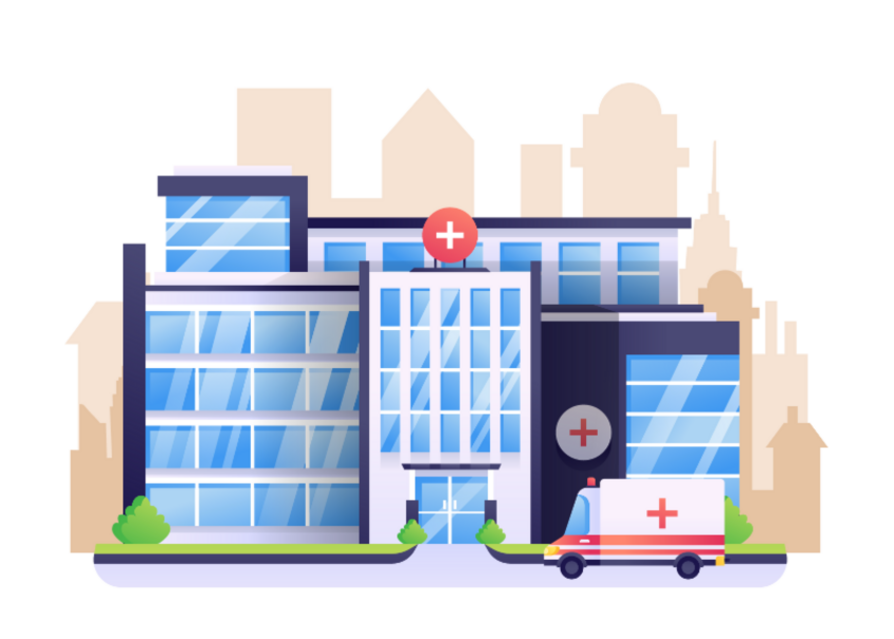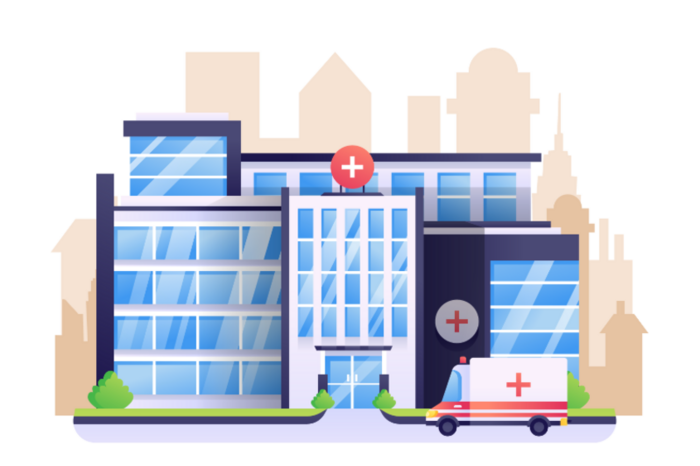Img Source - Deemak Daksina
To provide effective patient care, it’s essential for medical facilities to constantly improve their work. Bluetooth® technology in healthcare can help with this. Particularly, Bluetooth® Low Energy makes it possible to implement a system for monitoring patients and tracking objects in real time at a hospital. Recently, the technology has become more popular. Industry forecasts show that by 2026, the Bluetooth® LE market will amount to over $16.7 billion, with a CAGR of 19.68%.
Using Bluetooth® / Bluetooth® Low Energy in healthcare
Bluetooth® Low Energy is a wireless communication technology that is designed to exchange data over short distances. It works with low power consumption and allows you to determine the location of objects with an accuracy of 3 ft. For it to work, you need to use special sensors (known as beacons). They are installed indoors and help track the movements of both patients and staff, as well as medical equipment, and other types of assets.
There are many application scenarios for Bluetooth® in healthcare. Bluetooth®-based systems are an effective solution for patient tracking, indoor navigation, space monitoring, or blood/vaccine tracking, and getting insights into the day-to-day operation of a hospital.
The options you have with Bluetooth® Low Energy tracking systems
Ensuring Patient Safety
An important feature of Bluetooth® LE tracking systems is real-time patient tracking which allows staff to keep them safe and provide emergency care on time. The monitoring system determines a patient's location in a matter of seconds and builds the shortest route to them. This is especially important when it comes to those suffering from dementia or Alzheimer's.
To ensure monitoring, each patient is given a wristband/tag badge. When they move around the hospital, beacons in different rooms read the data from the tag and transmit it to the server for further processing. Further information is sent to the doctor's smartphone or PC.
Patient tracking based on Bluetooth® LE technology makes the work of medical staff more efficient. Nurses can easily find the right patient and quickly get to them in case of emergency. Bluetooth® Low Energy in healthcare improves patient safety and allows staff to save their working time searching for patients.
Patient monitoring
With Bluetooth® LE technology, staff doesn’t need to constantly read and record patient vital signs. The system monitors the state of patients on its own and transmits the following data to the central computer:
- stethoscope indicators;
- blood sugar;
- heart rate;
- blood pressure.
The automatic transfer allows doctors to focus on treatment without wasting time on records. This approach eliminates any possible mistakes in the display of vital signs, and also helps doctors during operations and emergencies when they need to quickly review patient data.
Indoor Asset Tracking
Managers and staff can track and control the movement of valuable hospital assets. The Bluetooth® LE tracking system allows you to monitor any object, whether it be wheelchairs, ventilators, cardiographs, and other devices. Using Bluetooth® in hospitals, you can instantly determine the location of equipment and find out if it’s currently available.
Monitoring is carried out via sensors that are installed on the monitored equipment. Based on the radio signals from the beacons, the system captures the object and displays its exact location on the digital map. Thanks to the indoor tracking system, it’s possible not only to track equipment but also to prevent its removal outside the hospital. As soon as the equipment crosses a specified boundary, the system immediately sends a notification to the medical staff. This helps prevent theft and ensure the safety of assets.
Vaccine/blood movement monitoring
Monitoring and correctly identifying blood products or vaccines is quite pricey. Usually, drugs have a limited shelf life and require strict storage conditions with a certain temperature and humidity level. To effectively manage these processes, it’s worth implementing Navigine’s Bluetooth® LE-based tracking, which will record all changes and help reduce costs.
Thanks to the tracking platform, medical staff can determine how long vaccines/blood have not been used, and also ensure they’re applied properly. The system allows you to accurately identify drugs, determine their location, and monitor if the correct temperature is maintained in storage areas. All of this combined increases the efficiency of the hospital and helps to avoid unfortunate mistakes.
Monitoring the space
When Navigine’s technology is introduced into the infrastructure of the clinic, beacons are installed in different places indoors and can be equipped with additional features for monitoring the surroundings. In addition to this, the system actively uses built-in smartphone sensors (e.g. accelerometer, barometer, magnetic field sensor). This allows you to control air temperature, humidity, and other indicators that are crucial for maintaining optimal sanitary and hygienic conditions within the building.
Monitoring can be carried out in any place in the hospital, such as wards, treatment rooms, drug storage warehouses, etc. With it, the medical staff gets the opportunity to provide a comfortable stay at the clinic and quickly identify issues that require increased attention from the management. All data is transmitted in real time and is available for analysis and subsequent decision-making.
Also, thanks to a special tool called geofencing, it is possible to track certain areas inside hospitals (hazardous areas, departments of infectious diseases, laboratories, and so on) and track the entrance to these areas by hospital employees. This ensures safety and reduces the number of emergency situations.
Staff monitoring/map search
Bluetooth® technology in healthcare can be successfully used to track the movements of medical staff. The management is provided with data on the daily activity of employees, which allows for increasing productivity and adjusting tasks as they go. When using the system, the management receives the following data:
- the location of a particular employee at the current moment;
- staff visits to restricted areas;
- time spent by employees in a particular zone;
- tracking the start and finish of each shift;
- the history of the staff movement within the hospital.
The obtained data can then be used to improve employee efficiency and reduce the number of emergencies. The system drastically improves staff management, helps make quick decisions in emergencies, and increases patient satisfaction with the hospital.
Optimizing processes with detailed analytics
The system not only provides navigation and tracking inside the hospital but also detailed analytics to optimize workflows. It can be used to obtain a wide range of data, such as:
- room occupancy;
- the number of available beds;
- staff time tracking;
- assets that are currently being used;
- movement history of equipment or staff;
- determining zones with the highest and lowest traffic.
The system constantly collects analytics and transmits them in real time. After obtaining the statistics, management can improve patient care, optimize logistics within the clinic, and minimize the number of emergencies.
Options for using Bluetooth® Low Energy navigation systems
Indoor navigation
Bluetooth® Low Energy technology greatly simplifies indoor navigation. Many visitors are unfamiliar with the numerous buildings, floors, and hallways of a medical facility, so it can be difficult for them to quickly get to the right room. When using Bluetooth® LE-based indoor wayfinding, it’s much easier to navigate the space. With the mobile app, you can:
- build a digital map of the hospital;
- determine the shortest route to points of interest;
- access turn-by-turn wayfinding through a smartphone in real time;
- get useful tips to quickly find the right place.
The system can work both inside one particular building and between several wings of a medical facility. When using it, seamless navigation is applied, which means that the visitor can effortlessly switch between the two modes. Thanks to Navigine’s solution, patients can easily find rooms or doctor’s offices, which improves service quality and makes people more loyal to a particular facility.
Benefits of Bluetooth® Low Energy
Bluetooth® LE technology was specifically designed for devices that need to constantly stay connected. It successfully works with smartphones powered by iOS or Android and allows you to create convenient mobile apps with real-time navigation for hospitals and other medical facilities. The key benefits of Bluetooth® Low Energy include:
- Low power consumption: data from the beacons is transmitted in short bursts, and when there’s none, the devices go into sleep mode.
- Interference immunity: sensors transmit data even if there are strong sources of interference or other infrastructure nearby.
- Affordable equipment: the implementation and subsequent maintenance of the system is available to most medical facilities.
- Security: data protection is carried out through authorization, encryption, authentification, etc.
Navigine develops efficient Bluetooth® Low Energy-based positioning and indoor navigation tools for the healthcare industry. To learn more about our software products, contact our staff by filling out the feedback form on the website or book a free Zoom demo:



